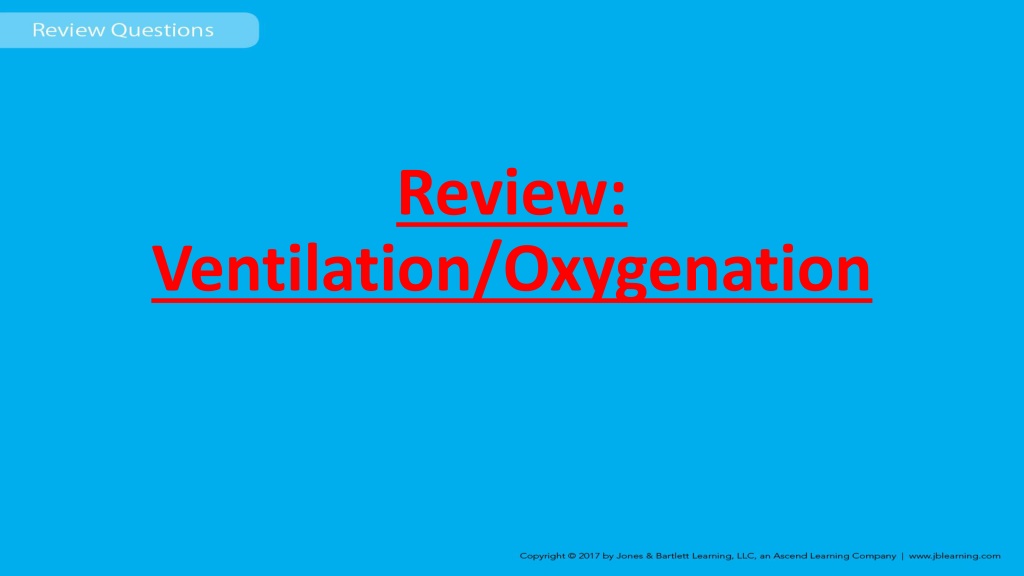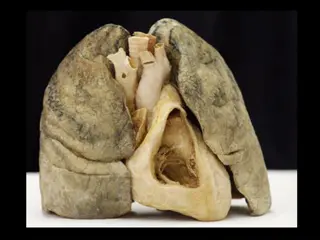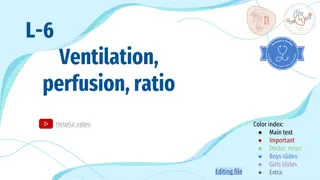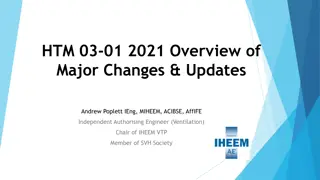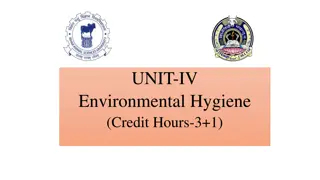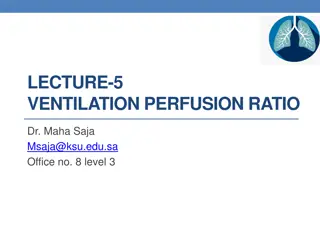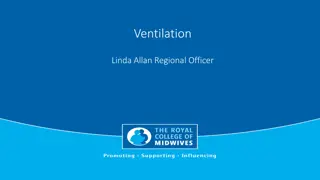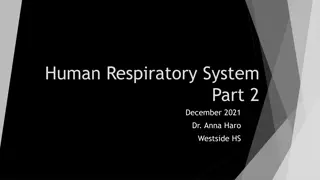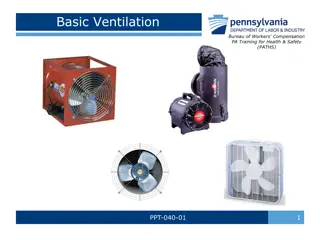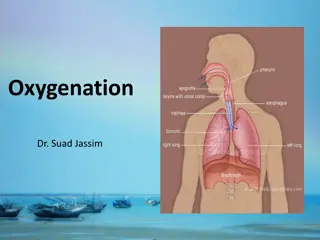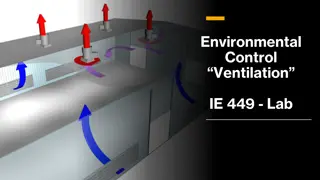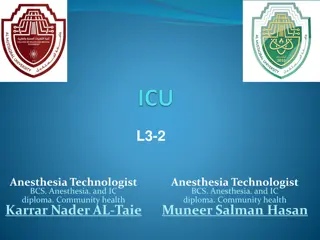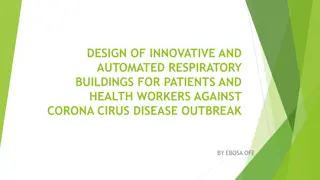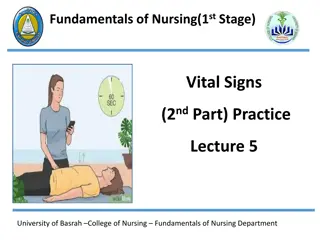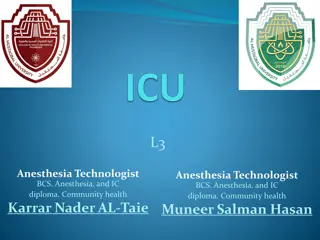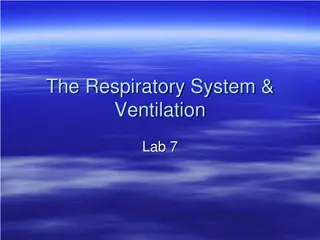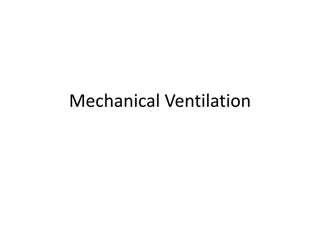Understanding Ventilation and Oxygenation in Respiratory Care
Review covers key concepts of ventilation and oxygenation, including the control of breathing, assessment of tidal volume, and the roles of different respiratory centers. Learn about the importance of observing chest rise to assess tidal volume accurately. Gain insights into the brain stem's pivotal role in regulating breathing.
Download Presentation

Please find below an Image/Link to download the presentation.
The content on the website is provided AS IS for your information and personal use only. It may not be sold, licensed, or shared on other websites without obtaining consent from the author. Download presentation by click this link. If you encounter any issues during the download, it is possible that the publisher has removed the file from their server.
E N D
Presentation Transcript
Review: Ventilation/Oxygenation
Review 1. Breathing is controlled by an area in the: A. lungs. B. brain stem. C. spinal cord. D. diaphragm.
Review Answer: B Rationale: The pons and the medulla are the respiratory centers in the brain stem that control breathing.
Review (1 of 2) 1. Breathing is controlled by an area in the: A. lungs. Rationale: The lungs contain small pockets called alveoli where the exchange of oxygen and carbon dioxide takes place. B. brain stem. Rationale: Correct answer
Review (2 of 2) 1. Breathing is controlled by an area in the: C. spinal cord. Rationale: Impulses are sent down the spinal cord from the brain stem. D. diaphragm. Rationale: The diaphragm receives the impulses that cause it to contract and bring air in.
Review 2. The EMT should assess a patient s tidal volume by: A. observing for adequate chest rise. B. assessing the facial area for cyanosis. C. counting the patient s respiratory rate. D. measuring the patient s oxygen saturation.
Review Answer: A Rationale: Tidal volume the volume of air that is moved into or out of the lungs in a single breath is assessed by observing for adequate chest rise. If shallow chest rise is noted, the patient s tidal volume is likely reduced.
Review (1 of 2) 2. The EMT should assess a patient s tidal volume by: A. observing for adequate chest rise. Rationale: Correct answer B. assessing the facial area for cyanosis. Rationale: Cyanosis is an indication of hypoxia, not tidal volume.
Review (2 of 2) 2. The EMT should assess a patient s tidal volume by: C. counting the patient s respiratory rate. Rationale: Counting the respiratory rate gives you minute volume: the number of times a patient breaths in 1 minute. D. measuring the patient s oxygen saturation. Rationale: Oxygen saturation is an indication of tissue perfusion, which is the amount of oxygen attached to the hemoglobin.
Review 3. In an otherwise healthy individual, the primary stimulus to breathe is a(n): A. increased level of oxygen in the blood. B. decreased level of oxygen in the blood. C. increased level of carbon dioxide in the blood. D. decreased level of carbon dioxide in the blood.
Review Answer: C Rationale: Under control of the brain stem, rising levels of carbon dioxide in arterial blood normally stimulate breathing in an otherwise healthy patient.
Review (1 of 2) 3. In an otherwise healthy individual, the primary stimulus to breathe is a(n): A. increased level of oxygen in the blood. Rationale: Increased levels of oxygen can be a result of hyperventilation syndrome. B. decreased level of oxygen in the blood. Rationale: This is typically not normal in healthy individuals. It can be a sign of inadequate breathing and results in hypoxia.
Review (2 of 2) 3. In an otherwise healthy individual, the primary stimulus to breathe is a(n): C. increased level of carbon dioxide in the blood. Rationale: Correct answer D. decreased level of carbon dioxide in the blood. Rationale: This is usually not seen in healthy adults. It is typically a result of hyperventilation syndrome.
Review 4. Signs of adequate breathing in the adult include all of the following, EXCEPT: A. pink, warm, dry skin. B. shallow chest rise. C. symmetrical chest movement. D. a respiratory rate of 16 breaths/min.
Review Answer: B Rationale: Signs of inadequate breathing in the adult include a respiratory rate less than 12 breaths/min or greater than 20 breaths/min, shallow chest rise (reduced tidal volume), cyanosis, and asymmetrical chest movement (both sides of the chest do not move equally).
Review (1 of 2) 4. Signs of adequate breathing in the adult include all of the following, EXCEPT: A. pink, warm, dry skin. Rationale: This shows that breathing and perfusion are adequate. B. shallow chest rise. Rationale: Correct answer
Review (2 of 2) 4. Signs of adequate breathing in the adult include all of the following, EXCEPT: C. symmetrical chest movement. Rationale: This shows that the mechanical process of breathing is adequate, equal, and symmetrical bilaterally. D. a respiratory rate of 16 breaths/min. Rationale: This is a normal respiratory rate for an adult.
Review 5. During insertion of an oropharyngeal airway into an unconscious patient, she begins to vomit. The first thing you should do is: A. turn the patient on her side. B. remove the airway at once. C. suction the patient s mouth. D. use a smaller-sized oral airway.
Review Answer: A Rationale: Whenever an unconscious patient begins to vomit whether you are inserting an oropharyngeal airway or not you should immediately turn the patient onto his or her side; this will allow drainage of vomit from the mouth and prevent aspiration. After the patient is on his or her side, remove the oral airway and suction the mouth.
Review (1 of 2) 5. During insertion of an oropharyngeal airway into an unconscious patient, she begins to vomit. The first thing you should do is: A. turn the patient on her side. Rationale: Correct answer B. remove the airway at once. Rationale: Remove the airway after the patient has been rolled onto her side.
Review (2 of 2) 5. During insertion of an oropharyngeal airway into an unconscious patient, she begins to vomit. The first thing you should do is: C. suction the patient s mouth. Rationale: This must be completed after the patient is positioned and the airway is removed. D. use a smaller-sized oral airway. Rationale: Oropharyngeal airways are contraindicated if the patient has a gag reflex.
Review 6. In which of the following patients would a nasopharyngeal airway be contraindicated? A. A semiconscious patient with a gag reflex B. An unconscious patient with an intact gag reflex C. A patient who fell 20 feet and landed on his or her head D. An unconscious patient who gags when you insert an oral airway
Review Answer: C Rationale: Nasopharyngeal (nasal) airways are contraindicated in patients with severe head or facial injuries and should be used with caution in patients who have delicate nasal membranes or are prone to nosebleeds. The nasal airway is better tolerated in patients who are semiconscious and/or those with a gag reflex.
Review (1 of 2) 6. In which of the following patients would a nasopharyngeal airway be contraindicated? A. A semiconscious patient with a gag reflex Rationale: This airway works best with an intact gag reflex. B. An unconscious patient with an intact gag reflex Rationale: This airway works best with an intact gag reflex.
Review (2 of 2) 6. In which of the following patients would a nasopharyngeal airway be contraindicated? C. A patient who fell 20 feet and landed on his or her head Rationale: Correct answer D. An unconscious patient who gags when you insert an oral airway Rationale: This airway can be used when the patient gags with an oral airway.
Review 7. You are delivering oxygen to a patient with a nasal cannula at 4 L/min when he begins to complain of a burning sensation in his nose. You should: A. remove the nasal cannula. B. apply a nonrebreathing mask. C. attach an oxygen humidifier. D. increase the flow rate to 6 L/min.
Review Answer: C Rationale: Administering dry oxygen through a nasal cannula especially over a prolonged period of time can result in drying of the nasal membranes, in which case the patient might complain of a burning sensation in the nose. Humidified oxygen will serve to keep the nasal membranes moist.
Review (1 of 2) 7. You are delivering oxygen to a patient with a nasal cannula at 4 L/min when he begins to complain of a burning sensation in his nose. You should: A. remove the nasal cannula. Rationale: The oxygen should be humidified. B. apply a nonrebreathing mask. Rationale: This can still cause an irritation due to providing dry oxygen.
Review (2 of 2) 7. You are delivering oxygen to a patient with a nasal cannula at 4 L/min when he begins to complain of a burning sensation in his nose. You should: C. attach an oxygen humidifier. Rationale: Correct answer D. increase the flow rate to 6 L/min. Rationale: The oxygen should be humidified.
Review 8. A patient is found unconscious after falling from a third floor window. His respirations are slow and irregular. You should: A. place him in the recovery position. B. apply oxygen via a nonrebreathing mask. C. suction his airway for up to 15 seconds. D. assist his breathing with a bag-valve mask.
Review Answer: D Rationale: The patient is not breathing adequately. Slow, irregular respirations will not result in adequate oxygenation. You should assist the patient s breathing with a bag-valve mask attached to 100% oxygen. Suctioning is indicated if the patient has blood or other liquids in the airway; there is no evidence of this in the scenario.
Review (1 of 2) 8. A patient is found unconscious after falling from a third floor window. His respirations are slow and irregular. You should: A. place him in the recovery position. Rationale: Due to the significant MOI, the patient will be placed supine on a long backboard with the head immobilized. B. apply oxygen via a nonrebreathing mask. Rationale: A BVM is indicated if the patient s respirations are less than 8 breaths/min.
Review (2 of 2) 8. A patient is found unconscious after falling from a third floor window. His respirations are slow and irregular. You should: C. suction his airway for up to 15 seconds. Rationale: Suction is indicated if a patient has blood or other secretions in the airway. D. assist his breathing with a bag-valve mask. Rationale: Correct answer
Review 9. When ventilating an apneic adult with a bag-valve mask, you should squeeze the bag: A. until it is empty. B. over a period of 2 seconds. C. at a rate of 20 breaths/min. D. until visible chest rise is noted.
Review Answer: D Rationale: When ventilating any apneic patient with a bag-valve mask, you should squeeze the bag over a period of 1 second and observe for visible chest rise. Ventilate the apneic adult at a rate of 10 to 12 breaths/min (one breath every 5 seconds). Ventilate infants and children at a rate of 12 to 20 breaths/min (one breath every 3 seconds).
Review (1 of 2) 9. When ventilating an apneic adult with a bag-valve mask, you should squeeze the bag: A. until it is empty. Rationale: An appropriately sized bag for an adult will not totally empty. B. over a period of 2 seconds. Rationale: You should squeeze the bag over a period of 1 second.
Review (2 of 2) 9. When ventilating an apneic adult with a bag-valve mask, you should squeeze the bag: C. at a rate of 20 breaths/min. Rationale: Ventilate the apneic adult at a rate of 10 to 12 breaths/min (or one breath every 5 seconds). D. until visible chest rise is noted. Rationale: Correct answer
Review 10. You and your partner are ventilating an apneic adult when you notice that his stomach is becoming distended. You should: A. suction his airway for up to 15 seconds. B. reposition his head. C. increase the rate and volume of your ventilations. D. decrease your ventilation rate but use more volume.
Review Answer: B Rationale: Gastric distension occurs when air enters the stomach. Severe gastric distention can result in vomiting and aspiration if not recognized and treated. To minimize the amount of air that enters the stomach during ventilations, you should reposition the patient s head.
Review (1 of 2) 10. You and your partner are ventilating an apneic adult when you notice that his stomach is becoming distended. You should: A. suction his airway for up to 15 seconds. Rationale: Suctioning is indicated when there is blood or secretions in the airway. B. reposition his head. Rationale: Correct answer
Review (2 of 2) 10. You and your partner are ventilating an apneic adult when you notice that his stomach is becoming distended. You should: C. increase the rate and volume of your ventilations. Rationale: This action may result in even more air going into the stomach. D. decrease your ventilation rate but use more volume. Rationale: This action may result in even more air going into the stomach.
